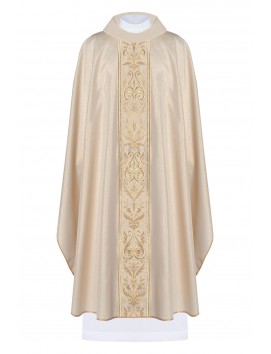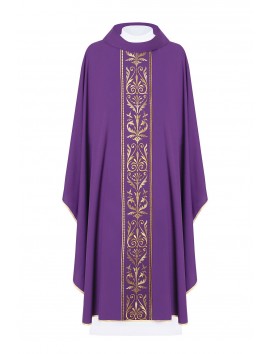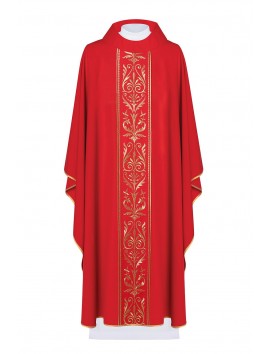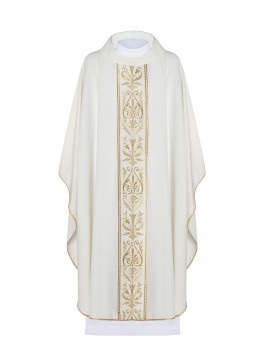Priests wear chasubles as part of their liturgical vestments during Mass and other liturgical celebrations. The chasuble is a sleeveless outer garment worn over the alb and stole. It is typically decorated with different colors and designs depending on the liturgical season or occasion. The chasuble has a rich history in the Catholic Church, and its origins can be traced back to the ancient Roman Empire. In the early Church, the chasuble was a simple garment worn by all clergy during Mass. Over time, however, the chasuble became more ornate and symbolic. Today, the chasuble is considered a symbol of the priest's role as a mediator between God and the people. It represents the priest's authority and dignity as an ordained minister and is a sign of his willingness to serve God and the Church. The chasuble also serves a practical purpose by covering the priest's clothing so that his attention is focused solely on the liturgy.
0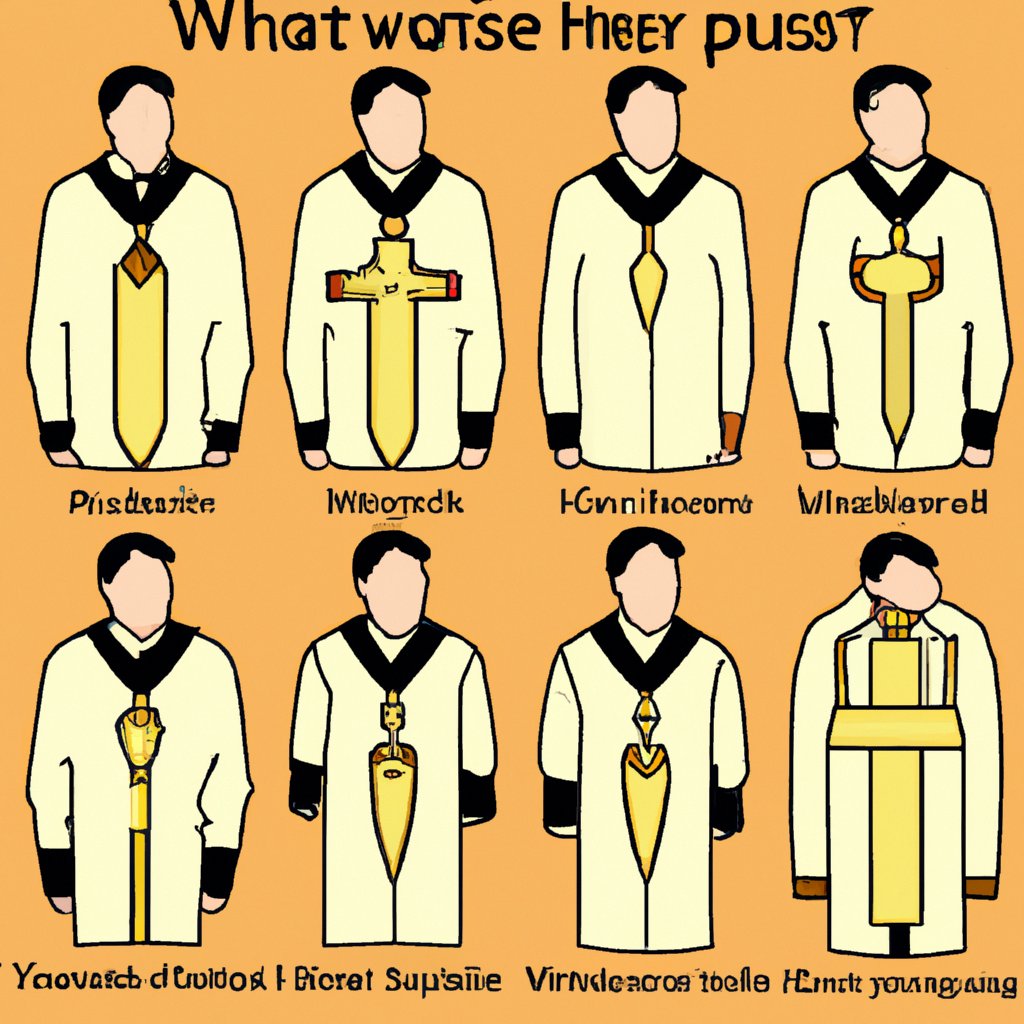
Can anyone wear a chasuble?
In the Catholic Church, only ordained ministers, such as priests and bishops, are permitted to wear chasubles during liturgical celebrations. This is because the chasuble is considered a symbol of the priest's authority and dignity as an ordained minister, and it is reserved for those who have received Holy Orders. There are, however, some exceptions to this rule. For example, under certain circumstances, a deacon who has received special permission from his bishop may be allowed to wear a chasuble during Mass. Also, in the case of a funeral or wedding, a family member or friend may be allowed to wear a chasuble as a symbol of their close relationship with the deceased or the couple. However, these exceptions are rare, and the general rule is that only ordained clergy may wear a chasuble during liturgical celebrations.
Can chasubles be worn outside Mass?
Traditionally, chasubles are worn only during liturgical celebrations, such as Mass, and not outside these occasions. The chasuble is considered a liturgical vestment, and its use is reserved for the celebration of the Eucharist and other sacraments. In some rare cases, however, there are exceptions to this rule. For example, a priest may wear a chasuble when administering the Sacrament of the Anointing of the Sick to someone who is unable to attend Mass. In addition, some religious communities may wear chasubles during private devotions or spiritual exercises. These instances are rare, however, and the general practice is to use chasubles only during liturgical celebrations.
Does a priest have to wear a chasuble?
In the Catholic Church, the use of the chasuble is mandatory for the priest during the celebration of the Eucharist, which is the most important liturgical celebration of the Church. According to the General Instruction of the Roman Missal, the chasuble is the proper vestment of the priest celebrating Mass and represents the "fullness of the priesthood”. It is a symbol of the love of Christ which covers and surrounds the priest as he offers the Sacrifice of the Mass.
There are, however, some exceptions to this rule. For example, under certain circumstances, such as when Mass is celebrated outdoors in extremely hot weather, the bishop or bishops' conference of a particular country may permit the use of a stole in place of the chasuble. Even in such cases, however, the stole must be worn over a liturgical alb and be of a color appropriate to the liturgical season or celebration.
Is the chasuble only worn during Holy Mass?
Traditionally, the chasuble is worn only during liturgical celebrations such as Mass and other sacraments. The chasuble is considered a liturgical vestment, and its use is reserved for the celebration of the Eucharist and other sacraments. There are, however, some exceptions to this rule. For example, a priest may wear a chasuble when administering the Sacrament of the Anointing of the Sick to someone who is unable to attend Mass. In addition, some religious communities may wear chasubles during private devotions or spiritual exercises. These instances are rare, however, and the general practice is to use chasubles only during liturgical celebrations.
What goes under a chasuble?
The chasuble is an outer vestment worn by a priest during the celebration of the Eucharist or other liturgical celebrations. Under the chasuble, a priest usually wears an alb, which is a long, white linen garment that covers the body from the neck to the feet. The alb is usually fastened at the waist with a cincture, which is a cord or rope tied around the waist.
In addition to the alb and cincture, a priest may also wear a stole, which is a long, narrow strip of cloth worn around the neck and hanging down in front. The stole is a symbol of the priest's authority and is worn over the chasuble during the liturgy of the Eucharist.
Who is allowed to wear a chasuble?
The chasuble is a liturgical vestment normally worn by bishops and priests during the celebration of the Eucharist or other liturgical events. Deacons do not normally wear chasubles, but may wear dalmatics or other liturgical vestments appropriate to their role in the liturgy.
It's important to note that the use of chasubles is reserved for ordained clergy and is not available for general use by lay or non-ordained ministers. However, there are some exceptions to this rule in certain circumstances, such as when a bishop or priest grants permission for a layperson to wear a chasuble for a special liturgical celebration, such as a re-enactment of a historical event or a special cultural celebration.
Why do Catholic priests wear chasubles?
The chasuble is a liturgical vestment worn by Catholic priests for centuries during the celebration of the Eucharist and other liturgical events. Its purpose is to signify the priest's role as a servant of Christ and to express the beauty and solemnity of the liturgy. The chasuble is a large, flowing garment that covers the priest's entire body, symbolizing the all-encompassing love of Christ that covers and protects all humanity. Its shape also represents the seamless garment worn by Christ at his crucifixion, and its colors change according to the liturgical season or feast being celebrated. The use of the chasuble also emphasizes the continuity of the liturgical traditions of the Catholic Church, connecting the priest and the congregation to the rich history of the Church and its teachings. Overall, the chasuble is a powerful symbol of the Catholic faith and its rich liturgical traditions.
Why does a bishop wear a chasuble?
Like priests, bishops wear a chasuble during the celebration of the Eucharist or other liturgical events. However, the chasuble worn by a bishop is usually more elaborately decorated than that of a priest and may have additional symbols such as the bishop's coat of arms or images of saints or other religious figures.
The chasuble worn by a bishop symbolizes his role as a successor of the apostles and shepherd of the faithful. It also represents the bishop's authority and responsibility to preach the Gospel, administer the sacraments, and govern the Church in his diocese.
In addition to the chasuble, bishops also wear other liturgical vestments, such as the miter, a pointed hat that signifies the bishop's authority, and the crozier, a staff that represents his pastoral care of the faithful.
Overall, the vestments worn by a bishop, including the chasuble, are rich in symbolism and carry deep spiritual significance for the bishop and the Catholic faithful.
Why is the chasuble important?
The chasuble is an important liturgical vestment worn by Catholic priests during the celebration of the Eucharist and other liturgical events. It is important for several reasons:
1. Symbolism: The chasuble is a symbol of the priest's role as a servant of Christ. The flowing garment represents the all-encompassing love of Christ that covers and protects all humanity.
2. Tradition: The use of the chasuble has been part of the liturgical tradition of the Catholic Church for centuries. Its use represents the continuity of the Church's liturgical traditions and connects the priest and the congregation to the rich history of the Church and its teachings.
3. Solemnity: The chasuble adds to the solemnity and beauty of the liturgy, enhancing the sense of awe and reverence felt by the faithful.
4. Differentiation: The chasuble helps to distinguish the priest from the congregation, emphasizing his unique role as leader and celebrant of the liturgy.

